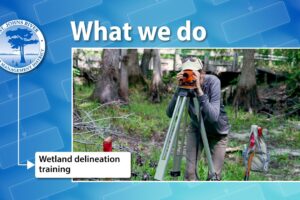A fledgling eagle finds a new family

Workers with the Audubon Center for Birds of Prey prepare for and release a juvenile eagle following its rehabilitation. The photos capturing the scene were provided by EagleWatch volunteer Katie Houvener and District staff of the eaglet at the District’s Lake Apopka North Shore property.
It had all the makings of a tragic tale: A juvenile bald eagle, too young to fly, was discovered on the ground in Lone Oak Cemetery in Leesburg.
Instead, rescuers are hopeful that the young bird has joined an adoptive family at the St. Johns River Water Management District’s Lake Apopka North Shore property in Orange County.
Our story begins with the rescue and delivery of the eaglet to the Audubon Center for Birds of Prey in Maitland, where she was assessed, treated for parasites over several weeks and transferred to the center’s Magic of Flight Barn to begin flight conditioning, says Shawnlei Breeding, Audubon EagleWatch program manager.
“By the time she was flying well enough for release, her family had left the nest and was no longer being seen in the cemetery,” says Breeding, whose army of 400 volunteers monitor more than 700 eagle nests throughout Florida. “Because fledglings aren’t self-sufficient right away, we used EagleWatch nest monitoring data to find a foster nest in the area with chicks of a similar age that she might join for supplemental feedings and coaching for life in the wild.”
Breeding knew where to turn. She contacted District Land Manager Maria Zondervan to determine whether the Lake Apopka North Shore offered a possibility.
“It just so happens that we are having a record year for bald eagle nests,” Zondervan says. “The number of nests has been growing at the North Shore. Eight years ago, there were three that we knew of; this year we’ve located 11.”
Luckily, one of the nests harbored eaglets that were about the same age as the wayward eaglet. Now, it was just a matter of prepping for her release. All eagles treated at the Audubon Center for Birds of Prey are banded with a federal leg band and a unique identification code before their release. Fledglings are also given a colored auxiliary band based on the type of nest in which they hatch: green for nests in trees and black for nests on artificial structures such as cell towers.
On April 23, Zondervan joined Breeding and EagleWatch volunteers as they released the bird at the North Shore. The eaglet, banded as K-32, flew directly to the nest and perched near the two eaglets that will hopefully become her new adopted siblings. EagleWatch volunteers are monitoring the nest in anticipation of a happy ending.
The Lake Apopka North Shore is among 700,000 acres of property the District owns or manages throughout its 18 counties. While the main intent of land ownership is to protect water resources, one of the extra benefits is the protection of wildlife found there.
“The growing bird population at Lake Apopka is just one more sign that our work is having a positive impact on water quality in what was once one of the most polluted lakes in Florida,” says St. Johns River Water Management District Executive Director Dr. Ann Shortelle. “We are grateful that our lands also offered Audubon’s experts a place to give this young eagle a chance to survive and thrive.”





